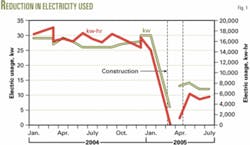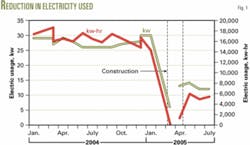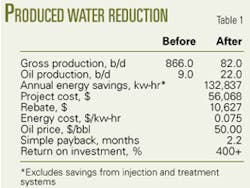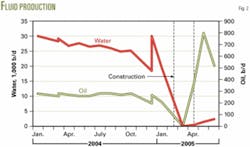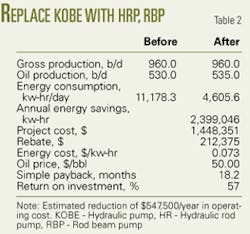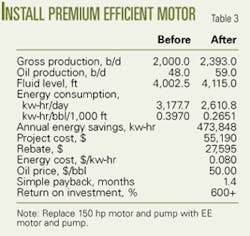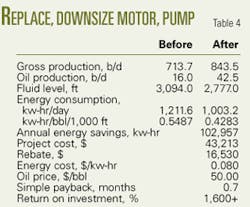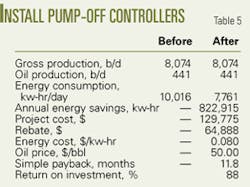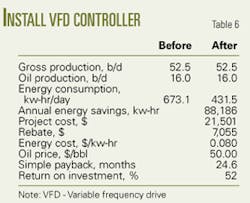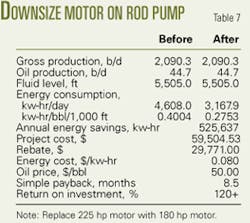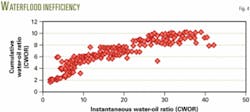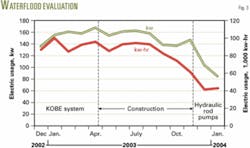Sample case studies on California oil fields show the benefits that producers can obtain from reducing their power consumption. Typical energy efficiency projects are viable economically with short payback periods and a high return on investment. But in spite of these attractive economics to increase energy efficiency, some producers continue inefficient operations.
At a time of high oil prices, perhaps some excess operational cost is of no concern, but in fact this is exactly the time to correct such problems. Experience shows that corrective measures have side benefits that can increase well productivity and reduce well-intervention costs, parameters that contribute to attractive project economics.
Oil field power consumption
Based on California Energy Commission statistics,1 California’s upstream oil and gas operations consume 5,160 Gw-hr, or 2% of California’s total energy consumption of 270,000 Gw-hr. These statistics include oil wells in California that produce at water cuts greater than 95%.
While it is economical to correct the problems and reduce water production, studies show that some operators are reluctant to make the effort. As a result, large amounts of electric power are wasted daily to lift water.
Also studies indicate that some wells have pumping units that operate so inefficiently that their electric power consumption is often 8-10 times more than for an efficient pumping unit.
Three years ago, the US Department of Energy (DOE), within its PUMP program, awarded two Petroleum Technology Transfer Council (PTTC) regional resource centers (West Coast and South Mid-Continent) a contract to identify preferred operating practices that address major constraints on oil production in those areas.
DOE intended the PUMP program to identify and disseminate successful practices to aid US oil operators in managing their fields. During one phase of the study in California, the PTTC identified several reasons for small operators hesitating to take advantage of modern technologies for improving efficiency and reducing operating costs.
For many oil and gas operators, implementing a corrective measure implies uncertainty, and uncertainty is uncomfortable. For some it is fear of failure. Also new technologies may require skill and abilities beyond their capabilities.
For some operators with marginal wells, the lack of enthusiasm derives from a fear of losing something of value, while for others, it may be a misunderstanding and distrust of new technologies.
Operators resist change when they do not understand its implications and fear that it might cost them much more than they gain. In some cases, the study noted that a shortage of personnel prevents operators from taking on a new corrective measure.
Power-cost reduction
Producers can reduce their power bill for producing and injection wells in several ways. These include real-time monitoring and control of electrical loads with such off-the-shelf technologies as pump-off controllers, variable-speed drives, high-efficiency submersible pumps, improved power quality, hydraulic rod pumps, and smaller motors.
In some cases, operators can use waste gas and stranded gas for in-field generation of electricity.
For mature fields with high water cuts, operators often have opportunities to pinpoint and plug off sources of excess water with several available technologies, depending on the type of well completion and reservoir rock lithology.2
Excess water production has several causes and corrective measures vary with the geological environment.
The geology in California’s Los Angeles basin consists of turbidites and is characterized by large intervals of alternating sand-shale sequences. Water saturations in sands vary widely, and any sand, regardless of depth, can be wet.
Operators typically complete wells in multiple intervals throughout several hundred feet of the formation. This requires a need to run fluid-entry survey data to identify the nature and contribution of individual zones.
Pilot studies
In 2001, the PTTC and EPRI-PEAC, with funding from the California Energy Commission, conducted a pilot study on the electrical costs at selected California oil fields.3 Nineteen operators participated in the study.
A team dispatched by PTTC and EPRI-PEAC examined electricity-consumption records of pumping units in an effort to compile lifting-efficiency data. The team surveyed 1,174 wells of which 939 were producing wells and the remainder were injection wells.
Of the producing wells, 91% had rod pumps.
The sample size represented 2.3% of all California producing wells. Fields visited ranged from very small (2 wells) to relatively large fields (299 wells). The producing interval depth in the wells ranged from 600 to 12,500 ft.
For the purpose of comparing lifting efficiency, the team compiled gross production data, which in the fields surveyed ranged from 12 to 300,000 b/d.
For the rod pumps, prime-mover sizes ranged from less than 10 hp to more than 80 hp. Under the theoretical power requirements to lift 1 bbl of gross fluid and assigning efficiency factors, the study used a baseline of 0.5 kw-hr/bbl/1,000 ft to assess power consumption of individual wells.
The study indicated that more than 48% of the wells exceeded this baseline. It further estimated that the 939 producing wells could reduce electricity demand by 5 Mw if operators made proper adjustments and changed motor sizes.
Extrapolating this reduction to the 42,000 wells in California and ignoring diversity factors, the study estimated that electric demand could be reduced by more than 230 Mw.
Global Energy Partners study
The PTTC and EPRI-PEAC study led to a pilot program managed by Global Energy Partners LLC through the California Public Utilities Commission. This program was designed to provide incentives to oil producers to become more efficient.
The current program administered by Global and sponsored by the Southern California Edison (SCE) provides information and incentives to small and medium-sized producers to help them reduce electric operating costs. The program also addresses market failure and barriers that inhibit the installation of cost-effective energy saving equipment and practices.
Furthermore, the program aims at increasing the acceptance of new off-the-shelf and cost-effective technologies and using the program achievements to motivate other producers to adopt these practices.
Global and PTTC have collaborated during the last several years to actively address these issues, and operators have reduced power consumption in a number of wells because of these corrective measures.
The rebate programs conducted during 2002-05 and administered by Global involved the following corrective measures:
• Reduce produced water.
• Covert pumping system.
• Replace submersible motor and pump.
• Replace and downsize submersible motor and pump.
• Resize motor.
• Install pump-off controllers.
• Install variable-speed drive.
Sample case studies provide an estimation of the return on investment some operators have realized from taking advantage of these opportunities. The studies show a significant economic benefit in power-cost reduction and in many cases an increase in well productivity and reduced well-intervention cost.
In one case related to reducing water production, a producer completed a fluid-entry survey, completely reworked a well, and used sand to plug water entry areas. Fig. 1 shows the substantial reduction in electrical usage for this well, and Fig. 2 shows the reduction in water production and increase in oil production after these corrective measures.
Table 1 lists the associated economics for this work.
In another case, the project involved the replacement of a KOBE pump system with hydraulic rod pumps. The project included the conversion of 43 wells in three fields during a 7-month period.
Fig. 3 shows the reduction in electric use attained while Table 2 shows the economic benefits.
In a third case, the producer overhauled a well and replaced the existing submersible motor and pump with a new pump and premium efficient motor. Table 3 shows the reduction in energy consumption and the associated cost reduction. In addition, the overhaul of the well also increased its daily production.
In a case similar to the third case, a producer determined that a well had an oversized submersible motor. After installation of a lower horsepower motor and replacement of the pump as part of the well overhaul, the operator realized the economics shown in Table 4.
In another case, a producer installed 27 pump-off controllers in a rod-pumped field. Table 5 shows the economic benefits of this work.
Installation of a variable-speed drive on a rod pump motor to better match the motor to the pumping load helped another producer. Table 6 shows the economics for this project.
In a final example, a producer determined that the motor on a rod pump was oversized. Calculations indicated that a 20% reduction in motor size would still maintain the production rates. Table 7 shows the economics for this project.
Water production
A recent publication presented a technique for assessing waterflood inefficiency by the use of a plot (Fig. 4) of cumulative water-oil ratio (WOR) vs. instantaneous water-oil ratio (IWOR).4 Using this procedure, one can easily compute power savings given a few parameters concerning the oil and water end-point relative permeabilities.
As an example, a well in a Southern California oil field waterflood produces at 1,200 bbl/month with a CWOR of 8 and an IWOR of 40. If the high CWOR were reduced to 4 and the low CWOR to 2.2, the calculations for the amount of water volume reduced are as follows:
• Minimum annual reduction in water lifted = 12(1,200)(8-4) = 57,600 bbl.
• Maximum annual reduction in water lifted =12(1,200)(8-2.2) = 83,520 bbl.
• The average reduction in water lifted = (83,520 + 57,600)/2 = 70,560 bbl
The average annually energy saved is then 1.5(70,560) = 105,840 kw-hr, where 1.5 kw-hr is required to lift 1 bbl of water from 3,000 ft.
This prediction closely matches the actual energy saving realized in the first case study previously discussed.
Low efficiency operations
A lack of interest in implementing changes in electric operating practices wastes electric power and puts unnecessary demands on the California grid.
In addition, continued inefficiencies have implications for the operator, for fields, and for consumers because wells that are operated inefficiently may prematurely experience their economic limit.
Furthermore, through its programs, Global and PTTC have identified numerous wells that also need a focus on corrective measures to control excess water production with all the ensuing problems and costs associated with disposal, reduced oil productivity index, and a waste of electric power. ✦
References
1. Brown, R., and Koomey, J., Electricity Use in California: Past Trends and Present Usage Patterns, LBL-47992, Energy Analysis Department, Environmental Energy Technologies Division, Ernest Orlando Lawrence Berkeley National Laboratory, May 2002.
2. Reynolds, R., and Keiker, R., Produced Water and Associated Issues, Oklahoma Geological Survey Open-File Report 6-2003, June 2003.
3. Miller, C., and Ershaghi, I., Optimization of Electric Energy Consumption in Marginal California Oilfields, EPRI Report 500-03-062C, January 2003.
4. McLachalan, K., and Ershaghi, I., “A Method for Reservoir Management of Waterfloods,” Paper No. SPE 97829, SPE Eastern Regional Meeting, Morgantown, W.Va., Sept. 14-16, 2005.
The authors
Mark Reedy is a senior associate with Global Energy Partners LLC, Lafayette, Calif. He was Global’s project manager for the energy efficiency program targeted toward small hard-to-reach oil producers in southern California. Prior to joining Global, Reedy worked for Plains Electric Generation and Transmission Cooperative and Wisconsin Electric Power Co. Reedy has a BS in electrical engineering from the University of Colorado and is a registered Professional Engineer in Wisconsin.
Iraj Ershaghi is currently a professor and director of the petroleum-engineering program at the University of Southern California’s department of chemical engineering and material science. Prior to USC, he worked in oil and gas engineering for Agip Mineraria-SIRIP, Signal Oil and Gas Co., and the State of California. Ershaghi holds a PhD from USC. Since 1996, he has served as the director of PTTC’s west coast center.
